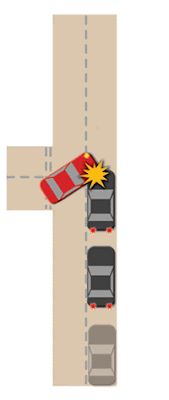Types of Anti-Lock Brake System
Anti-lock braking systems use different schemes depending on the type of brakes in use. We will refer to them by the number of channels -- that is, how many valves that are individually controlled -- and the number of speed sensors.
Four-channel, four-sensor ABS
This is probably the best ABS. There is a speed sensor on each of the four wheels and a separate valve for each wheel. With this system, the controller monitors each wheel individually to make sure it is achieving maximum braking force.
Three-channel, three-sensor ABS
This system is mostly found on pickup trucks with four-wheel ABS. It has a speed sensor and a valve for each of the front wheels, with one valve and one sensor for both rear wheels. The speed sensor for the rear wheels is located in the rear axle.
This system provides individual control of the front wheels, so they can both achieve maximum braking force. The rear wheels are monitored together. With this system, it is possible that one of the rear wheels will lock during a stop, reducing brake effectiveness.
This system provides individual control of the front wheels, so they can both achieve maximum braking force. The rear wheels are monitored together. With this system, it is possible that one of the rear wheels will lock during a stop, reducing brake effectiveness.
One-channel, one-sensor ABS
This system is commonly found on pickup trucks with rear-wheel ABS. It has one valve, which controls both rear wheels, and one speed sensor, located in the rear axle.
The rear wheels are monitored together and they both have to start to lock up before the ABS kicks in. In this system it is also possible that one of the rear wheels will lock, reducing brake effectiveness.
This system is easy to identify. Usually there will be one brake line going through a T-fitting to both rear wheels. You can locate the speed sensor by looking for an electrical connection near the differential on the rear-axle housing.
What are the advantages of ABS braking systems compared to other hydraulic braking systems?
- The advantages of ABS brakes (anti-lock braking system), are just as the meaning of their acronym implies, they eliminate or greatly reduce the possibility of brake lock up and therefore provide a better chance of steering out of trouble.
- ABS brakes were designed to combat the problem of tire lock up and uncontrolled spins. Since brakes are most effective at slowing the car at a point just before wheel lock up, a system that provides for wheel braking while preventing wheel lock up is very desirable.
- Use of ABS is simple you mash the brake pedal and the computer takes over. No matter what the surface, ABS adapts to it. Even professional race car drivers can not adapt as quickly as a computer to changing surfaces. Most of those who live in the snowier regions know what patchy snow can be like.
- Steer ability of the vehicle is very well maintained.
What are the disadvantages of ABS braking system?
Stop Times - Anti-lock brakes are made to provide for surer braking in slippery conditions. However, some drivers report that they find the stopping distances for regular conditions are lengthened by their ABS system, either because there may be errors in the system, or because the clunking or noise of the ABS may contribute to the driver not braking at the same rate.
Delicate Systems - It's easy to cause a problem in an ABS system by messing around with the brakes. Problems include disorientation of the ABS system, where a compensating brake sensor causes the vehicle to shudder, make loud noise or generally brake worse.






